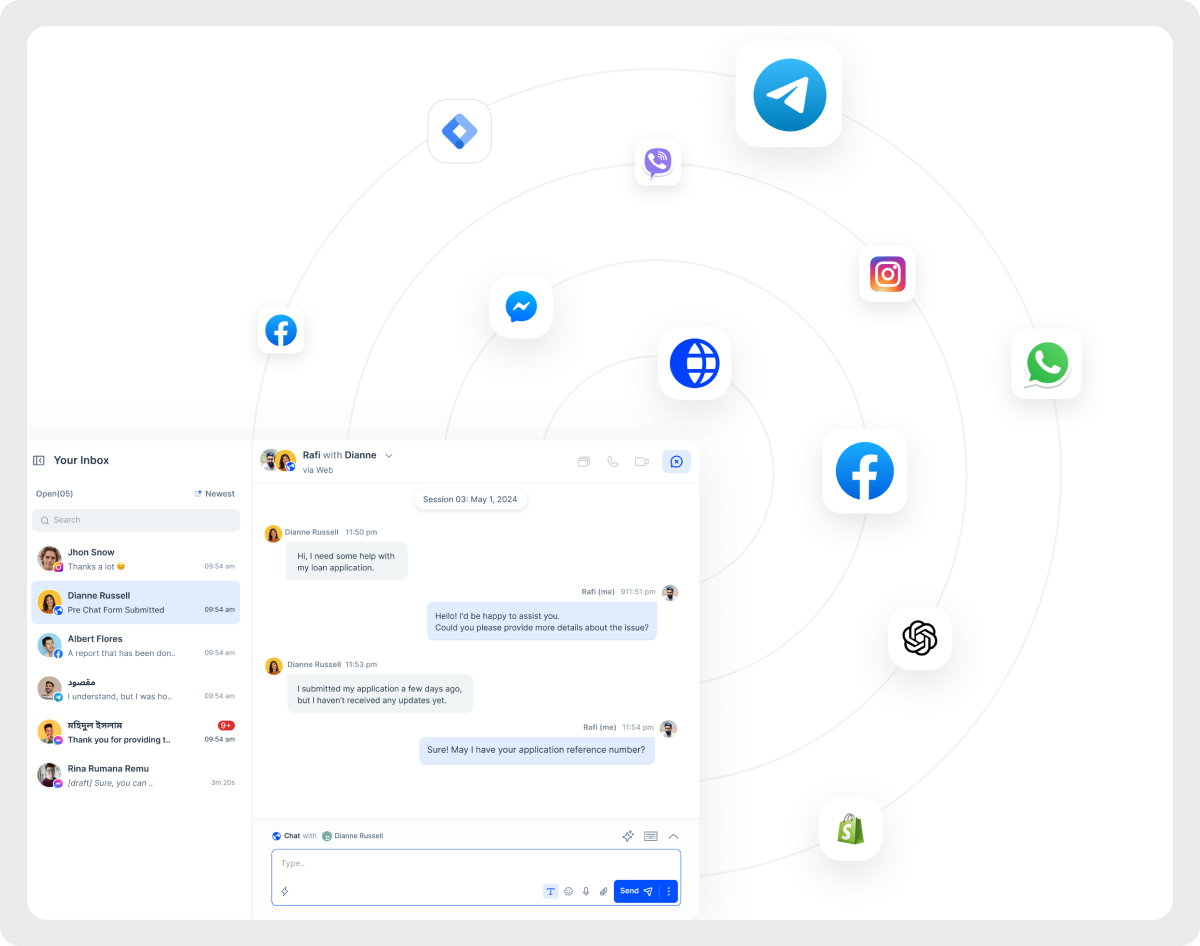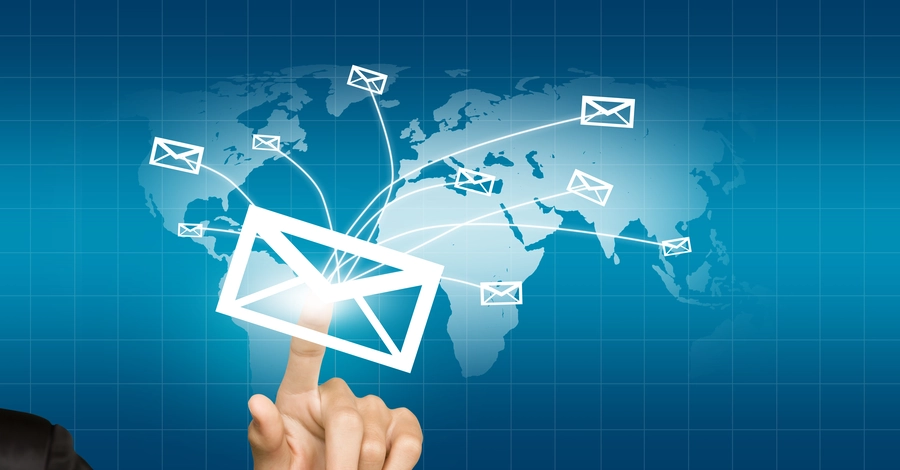What is Omnichannel Customer Service? Benefits & Strategies
- April 18, 2018
- 16 mins read
- Listen

Table of Content
What is Omnichannel Customer Service?
Omnichannel customer service means helping customers through multiple channels like live chat, social media, phone, email, and in-person, but all are connected and work together. This is to deliver consistent support across all customer touchpoints. It ensures that no matter how a customer reaches out, their experience stays smooth and consistent. For example, if someone starts a chat on a website but later calls for help, the support team already knows their issue without asking them to repeat everything. This makes customer service faster, easier, and more convenient.
Multichannel Vs Omnichannel
The biggest difference between omnichannel and multichannel is how they shape the customer experience. You need to understand the difference between these two approaches before you develop different strategies to offer best-in-class customer engagement and service.| Factors | Omnichannel | Multichannel |
| Focus | Customer Focused | Brand Focused |
| Integration | All channels are linked, sharing data and customer history. | Channels are independent, with little to no data sharing. |
| Context | Complete customer history and journey data across channels | Limited cross-channel customer data |
| Personalization | Hyper-personalized service based on customer data/journey | Less capacity for personalization |
| Channels | Live Chat, Phone, email, chat, SMS, social media, etc. | Typically focuses on traditional channels |
| Metrics | 360-degree customer relationship metrics | Channel-specific metrics only |
| Technology | Sophisticated, cloud-based, real-time omnichannel routing | Basic call routing, legacy on-premise systems |
| Best For | Businesses that prioritize seamless and personalized customer experiences | Businesses that just want to offer multiple support channels without deep integration. |
Benefits of Omni Channel Customer Service
Omnichannel customer service connects all support channels and makes interactions seamless and hassle-free. It helps businesses respond faster, keep customers happy, and increase sales. By unifying communication across platforms, companies can offer a smooth, personalized experience that builds trust and loyalty.Improved Customer Satisfaction
Customers feel satisfied when they don’t have to deal with unnecessary hassle or repeat themselves across different channels. Omnichannel customer service eliminates these frustrations by ensuring seamless, connected interactions.Omnichannel customer service develops customer satisfaction by leveraging these hassles. You can satisfy your customers as your all channels will be integrated by implementing omnichannel customer service.Enhanced Customer Experience
Through omnichannel integration, you can manage all customer interactions on different channels from a single place. A unified view of customer interactions across channels also simplifies the process of maintaining a consistent brand voice. By streamlining customer communication, you can ensure a cohesive experience at every touchpoint, and offer better customer service and experience.Improved Customer Loyalty
When customers feel valued and understood, they are more likely to stick with a brand and be loyal. Omnichannel strategies help businesses provide timely and accurate responses, which can significantly improve customer retention rates. By meeting customers where they are and providing consistent services, you can build stronger relationships, reduce churn, and increase repeat business.Boosted Agent Efficiency
Omnichannel customer service tools integrate various communication channels into a single platform. It lets customer service reps access all necessary information quickly.And send prompt responses from a centralized point improving their response times and reducing the need for repetitive tasks.Better Customer Retention
Customers expect instant response and when they get assistance across all their preferred channels in real-time, there is a significant reduction in the overall customer churn rate. When customers feel valued and understood, they are more likely to stay loyal to a brand. And thisBetter Data Collection and Insights
With omnichannel customer service, businesses can collect more relevant data from multiple communication touchpoints, gaining a comprehensive view of customer behavior and preferences. This data can be stored and analyzed in a centralized section to identify new trends, measure performance, and make informed decisions.Reduced Operational Costs
While initially, you need to invest in your omnichannel infrastructure, eventually, it will help you save costs in the long run. Centralized platforms reduce the need for multiple, separate systems and streamline processes, leading to lower operational costs. Additionally, improved efficiency and faster resolution times can reduce the overall cost of new customer acquisition.Key Channels Used in Omnichannel Customer Service
It’s not necessary to integrate all the available communication channels out there. You can do your survey, find out the most preferred channels of your customers, and integrate those. Some of the most popular channels are:

Emails
Email remains one of the most popular communication platforms due to its flexibility and wide accessibility. It allows customers to describe their issues in detail and attach all necessary documents. Email support is important because it provides a written record of all interactions, making it easier to track and resolve issues over time. To enhance the customer experience, make sure that you add email communication to your omnichannel customer service strategy.Mobile Apps
We all use mobile phones to browse various company websites and also expect a company to have its own mobile app where we not only can place orders but also get in-app support if required. Companies can integrate various features like live chat, FAQs, push notifications, and more. This makes sure that they offer best-in-class services and assistance on their mobile apps too. These apps provide a seamless user experience and allow businesses to engage with customers in a personalized and efficient manner.Physical Stores
For many businesses, traditional brick-and-mortar stores serve as the primary communication channel for engaging and delivering products to their consumers. Despite the rise of digital communication alternatives, many customers still want to see and evaluate products in person before making a buying decision.Social Media Channels
Social media platforms such as Facebook, Twitter, LinkedIn, YouTube, and Instagram have become integral parts of our lives. We also contact the customer support of any brand through social media. These channels are ideal for handling customer inquiries, addressing complaints, and collecting feedback. So, make sure to integrate these platforms when you offer omnichannel customer support.Company Website
As the digital face of a brand, your website is often the first point of contact where customers land to get more information about your product offerings or resolve issues. In the customer journey, the website serves an important role offering self-service options, live chat, and access to other support channels. So, make sure you integrate the website as a major communication channel in omnichannel customer service.Messaging Apps
Messaging apps like WhatsApp, Facebook Messenger, and Viber are becoming increasingly popular among customers and they have started using these platforms for communicating with brands too. These platforms allow for quick, real-time interactions and support multimedia messaging, such as photos and videos. They also enable businesses to automate responses for common inquiries and offer personalized services to their customers.To provide a truly omnichannel customer service experience, it’s essential to integrate all the communication channels your customers use. You can start by connecting a few, like social media and email, and gradually add more channels over time.REVE Chat simplifies this process, by seamlessly integrating all these communication channels including LinkedIn, YouTube, Google Business Messages, YouTube, Play Store, and Appstore. This ensures consistent service across all touchpoints, allowing your support team to manage and respond to customer interactions from one centralized platform.7 Key Strategies to Build an Omnichannel Customer Service
To provide a seamless customer experience, businesses need a structured approach to omnichannel customer service. This involves integrating multiple communication channels, ensuring consistency, and leveraging technology to meet customer expectations. Below is a step-by-step guide to building a strong omnichannel customer service strategy.- Identify Key Customer Touchpoints
- Choose and Prioritize the Right Channels
- Invest in the Right Technology & Infrastructure
- Train and Empower Your Customer Support Team
- Deliver a Consistent & Personalized Experience
- Track, Analyze & Optimize Performance
- Ensure Customer Data Security & Compliance
1. Identify Key Customer Touchpoints
Understanding how customers interact with your business is the first step in creating a seamless experience. Customers engage with brands across various platforms, including websites, social media, mobile apps, and in-store visits. Identifying these touchpoints helps businesses understand where customers seek support and how they move across different channels.Research & Analyze: Conduct customer behavior analysis to understand their common queries and interaction patterns. Look at website analytics, social media engagement, and customer feedback to determine the most-used channels.Define Your Audience: Segment your audience based on demographics, preferences, and past interactions. Understanding your customers’ needs allows you to tailor support across multiple platforms.Map the Customer Journey: Identify the different stages where customers interact with your business, from inquiry to post-purchase support. Mapping the journey helps in identifying gaps and improving the overall customer experience.2. Choose and Prioritize the Right Channels
Not all channels contribute equally to customer service. Prioritizing the right channels ensures that support is available where customers need it the most.Select the Best Channels: Determine where your customers prefer to communicate. Some may prefer live chat or social media, while others may rely on phone or email support.Prioritize Customer Support Needs: Ensure that your primary support channels are well-staffed and optimized for efficiency. For example, if live chat is a major touchpoint, ensure quick response times to enhance the experience.Analyze Channel Performance: Regularly track and assess which channels receive the most customer engagement and adjust resources accordingly to maintain efficiency.3. Invest in the Right Technology & Infrastructure
A successful omnichannel strategy relies on technology that integrates all customer interactions into a unified system. This ensures a smooth experience across different channels.Unify Customer Data: Use a centralized CRM system to store all customer interactions in one place. This allows support agents to access customer history and provide personalized assistance.Adopt an Omnichannel Service Platform: Implement a customer service solution that connects multiple channels, such as live chat, chatbot, phone support, and email, to provide a seamless transition between them.Offer Self-Service Options: Many customers prefer to find answers on their own. A well-organized knowledge base, FAQs, AI-powered chatbots, and community forums can improve customer satisfaction while reducing support workload.Optimize for Mobile: With more people accessing services via mobile devices, ensure that your customer service platform is mobile-friendly. Features like in-app chat and easy navigation enhance the mobile experience.4. Train and Empower Your Customer Support Team
An effective omnichannel strategy is not just about technology. It also depends on a well-trained customer service team that can handle interactions across multiple channels.Cross-Channel Training: Train customer support agents to handle inquiries across live chat, social media, phone, and email. This prevents silos and ensures consistent service quality.Empower Agents with Data & Flexibility: Give your support team access to customer data, purchase history, and past interactions so they can provide quick and personalized resolutions. Also, allows them the flexibility to make decisions that enhance customer satisfaction.Encourage Team Collaboration: Ensure seamless communication between departments like sales, support, and technical teams so that customer issues are resolved faster and more effectively.5. Deliver a Consistent & Personalized Experience
Customers expect a smooth, personalized experience no matter which channel they use. A strong omnichannel strategy ensures that interactions are unified, reducing frustration and enhancing satisfaction.Maintain Unified Messaging: Ensure that all communication across different platforms carries a consistent brand voice and information. For example, pricing details, promotions, and policies should be the same across email, live chat, and social media.Personalize Customer Interactions: Use customer data to personalize recommendations, greetings, and support interactions. A chatbot, for instance, can greet returning customers by name and provide relevant suggestions based on past interactions.Enable Seamless Transitions: If a customer switches from chat to phone support, they shouldn’t have to repeat their issue. A unified system allows agents to continue conversations without losing context.Proactive Customer Engagement: Instead of waiting for customers to reach out, use AI and analytics to anticipate their needs and offer assistance before issues arise.6. Track, Analyze & Optimize Performance
To improve customer service continuously, businesses need to measure their performance using key metrics and customer feedback.Monitor Key Performance Indicators (KPIs): Track important metrics such as response time, resolution time, customer satisfaction scores (CSAT), and Net Promoter Score (NPS) to measure success.Gather Customer Feedback: Conduct surveys, analyze online reviews, and monitor social media conversations to understand pain points and improve service strategies.Continuously Improve: Use the insights gained from analytics to refine your omnichannel approach, improve efficiency, and enhance customer satisfaction over time.7. Ensure Customer Data Security & Compliance
Customer trust depends on how well businesses handle data security and privacy. Its necessary to maintain the trust well of the customers.Implement Strong Security Measures: Use encryption, secure authentication, and compliance protocols (like GDPR and CCPA) to protect customer data.Maintain Transparency & Customer Control: Clearly communicate how customer data is collected and provide options for users to manage their data and privacy preferences.Building an omnichannel customer service strategy is about more than just being present on multiple channels. It’s about creating a seamless, connected, and customer-first experience. By integrating the right channels, investing in technology, training your team, and prioritizing personalization, businesses can improve satisfaction, build loyalty, and drive long-term success.Omnichannel Customer Service Challenges
Customers don’t like to repeat their problems every time they get in touch with your support department. An omnichannel customer strategy ensures that you can eliminate this issue by integrating multiple communication channels into a unified system. Your support reps get all the details of the interactions that happened with customers on multiple platforms from a single dashboard, take references, and offer personalized services. But there are some challenges too. Let’s discuss it!Have Patience and Financial Planning
For being omnichannel, you need substantial time and resources to set up and run which can initially feel tiring and complicated.Tips: Stay in there! With time, you will see good results and maintenance expenses will decrease. Work on making a good strategy, plan wisely, and focus on long-term success.Being Consistent Is Not Easy
Delivering a uniform customer experience across all communication channels is tough. Customers always expect the same level of service and personalized interactions with your support reps, regardless of which channels they use to contact you.Tips: You can opt for omnichannel customer support tools that seamlessly integrate all the customer touchpoints and you can see all the details from a single dashboard enabling you to offer personalized customer service.Data Collection from Various Channels
Collecting and consolidating customer data from all channels while maintaining accuracy can be quite challenging. Customers contact a support department through many channels like websites, mobile apps, emails, live chats, and social media. All these channels will have separate data that you need to collect and manage effectively.Tips: Stay organized and focused. Use customer communication tools that offer advanced analytics and help you to manage all this info efficiently.Resource Allocation
You need to have resources including employees, technology, and time to manage omnichannel customer service efficiently. For startups or small businesses arranging such resources can be challenging.Tips: Start with integrating a maximum of 2-3 communication channels at a time and take slow steps. Once you feel confident and start seeing positive results, expand by adding more channels.Inventory Management
Most retailers are already in omnichannel eCommerce, but managing inventory in real-time is challenging. They need to manage and keep a record of the inventory for both online and offline stores.Tips: To avoid overselling and customer support issues, get help from chatbots. Bots automate inventory management and centralize your inventory data for real-time visibility across all sales channels.Omnichannel Customer Service Examples
Here let’s look into some of the standout examples of companies that have mastered the art of omnichannel customer service, offering best-in-class services and experiences to their customers.Saudi Telecom Company (STC)
Saudi Telecom Company (STC) is the leading telecommunications provider in Saudi Arabia and a key player in the Middle East’s telecom and information technology (IT) sectors. With REVE Chat’s omnichannel customer engagement platform, STC is offering seamless customer service to 2.5 million people across multiple communication channels including their website, app, WhatsApp, Facebook, Instagram, Google Business Messages, YouTube, Playstore, Appstore, LinkedIn, and Twitter. It ensures that all the customer data is centralized allowing their teams to monitor, respond, and engage with customers across multiple touchpoints from a single dashboard without missing any important messages. Additionally, REVE Chat’s AI-driven chatbot sends prompt replies and resolves customer inquiries instantly, improving response times and enhancing the overall customer experience.Zappos
Zappos is an online shoe and clothing retailer that has won the hearts of millions because of its exceptional customer service. It provides customer support through multiple channels, including Twitter, text messaging, and a 24/7 call center. Regardless of the channels used by customers, their support agents have all the necessary information to seamlessly continue with any customer interaction.One of the key drivers of Zappos’ success is its generous 365-day return policy and free shipping, making it a top choice for customers. Their customer service is widely praised for consistently going “above and beyond” for the happiness and satisfaction of their customers.Casper
Casper is a popular online mattress and sleep products retailer known for offering outstanding shopping experiences. It has smartly crafted a seamless omnichannel customer service experience by integrating its website, mobile app, customer support team (called Sleep Specialists), and physical stores.Customers can easily explore and buy mattresses through their website. Those who prefer a hands-on experience can visit their physical stores to check the products personally. Additionally, Casper offers a 100-night trial with hassle-free returns. Throughout this journey, anytime if required the customers can get in touch with Casper’s Sleep Specialists via phone, email, or live chat on the website.Casper’s mobile app also offers outstanding features like sleep tracking, integration with other health apps, and personalized sleep advice. The deadly combination of convenience, flexibility, and comfort creates a truly holistic shopping experience. Impressive, isn’t it?Empowering Your Brand with Omnichannel Excellence
Omnichannel customer support is more than just a tactical move—it’s a strategic direction for businesses. To provide exceptional support at every customer touchpoint, companies must train their customer-facing teams to effectively interpret customer inputs and deliver accurate solutions to their issues.Combining a robust omnichannel platform with a well-trained, dedicated support team is important for companies if they want to stand strong in the competition. With REVE Chat, you can turn the promise of a truly omnichannel experience into reality.Frequently Asked Questions
Omnichannel customer service is a strategy that offers customers a seamless and consistent experience across multiple communication platforms. This approach integrates various channels such as phones, websites, physical stores, email, and social media to ensure customers can switch between channels without disruption.
An omnichannel service provides customers with a seamless and uninterrupted experience across their chosen channels, enhancing overall satisfaction and loyalty.
Small businesses can start by integrating a few key channels, like website and social media, using several CRM solutions, customer service tools, and gradually expand as they grow.
The future trends we can expect are AI and machine learning integration, advanced analytics and data utilization, increased use of augmented reality (AR) and virtual reality (VR), IoT-driven customer service and an increased focus on self-service options.
Balancing automation and human touch in omnichannel customer support requires a strategic approach that uses the best of these two. Chatbots can be used to automate various business operations and replying to customer queries 24/7 or when all the support reps are busy. On the other hand, complex issues that bots cannot handle should be transferred to human agents for faster resolution.



